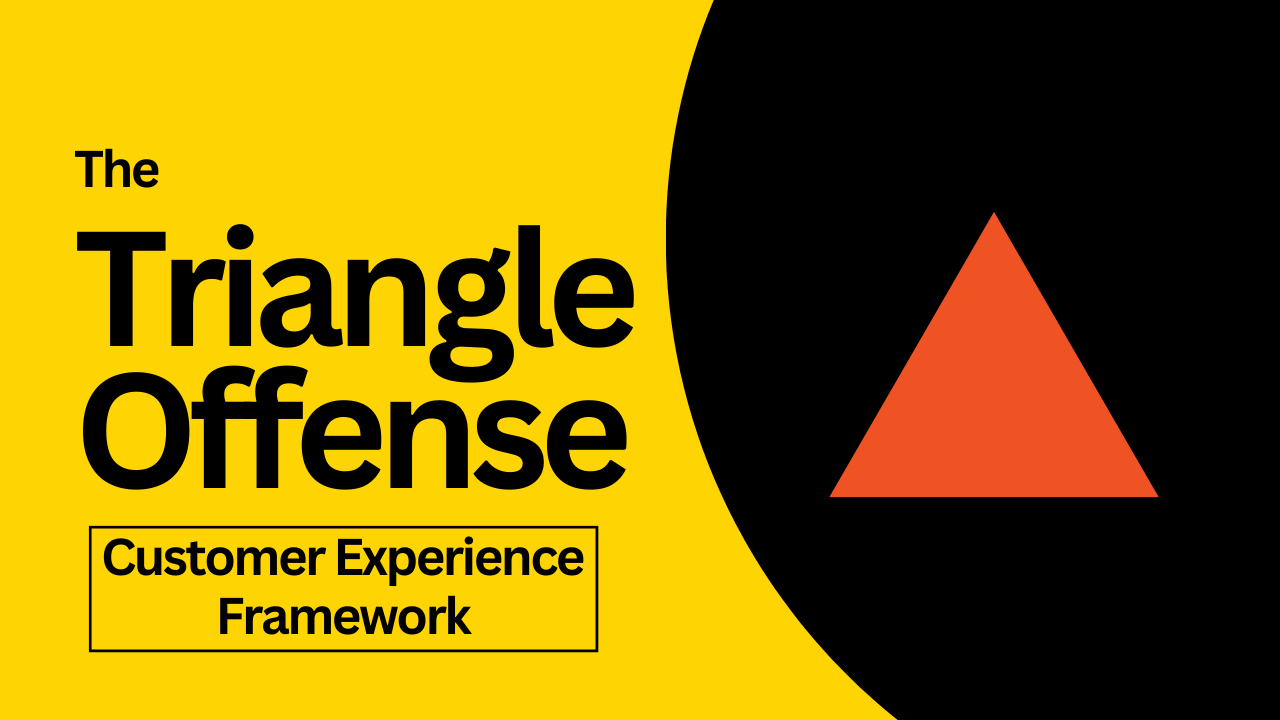Triangle Offense CX Framework: An Introduction
The Triangle Offense CX Framework enhances key customer experiences, generating business value. It unifies teams, focuses on the customer journey, and connects opportunities across segments.

Transform Your CX Strategy: Align Teams, Boost Revenue, and Create Satisfied Customers with the Triangle Offense
The Triangle Offense framework uses key CX documentation, workshops, and a meeting cadence to rapidly identify, prioritize, test, and evaluate business investments and launch new business opportunities that focus on returning high-growth revenue.
The purpose of the Triangle Offense customer experience framework is to help businesses create value faster for their customers by identifying which key moments in the customer experience fail to meet their expectations.
The framework will identify where to make major investments in the customer experience, with the end result of producing happy, loyal, repeat customers who generate revenue and profits for your business.
The Triangle Offense Framework’s Purpose
I have experienced firsthand the challenges of completing CX strategy objectives in large F500 organizations. The framework's purpose is to do the following:
- Unify all teams working on improving the customer experience.
- Focus on the entire customer journey.
- Connect opportunities across customer segments.
- Rapidly pinpoint the weakest (and/or missing) touchpoints in the customer journey.
- Focus on growing revenue and boosting ROI.
Unifying CX Teams: Enhancing Customer Experience Organization-Wide
The Triangle Offense CX framework aims to engage and connect your entire company by addressing the issue of disengaged CX teams within large organizations. Drawing from firsthand experiences and shared frustrations, this framework unifies diverse CX teams by providing them with key CX documentation such as omnichannel customer journey maps and executive audience experience maps. They can review this data as a group to understand their team's roles in improving customer experiences.
Holistic Customer Journey Mapping: Overcoming Business Biases of Key Customer Moments
The Triangle Offense CX framework aims to present a comprehensive customer experience for essential customer segments, addressing the issue of team biases toward specific journey stages such as the purchase or post-purchase phases. Recognizing that all teams have inherent biases, the framework broadens perspectives by emphasizing the entire customer experience.
Connecting Opportunities: Streamlining Efforts across Customer Segments
I've personally seen time and resources wasted due to teams duplicating each other’s efforts to tackle CX objectives. Thus, the framework utilizes opportunity backlogs linked to customer journey maps to prevent redundancy. This approach streamlines work and fosters a comprehensive understanding of customer perspectives.
Pinpointing Weak Links: Targeting Specific Core Enhancements to the Customer Experience
Constantly-shifting priorities have a demoralizing effect on employees and customers. The framework efficiently collects, identifies, and prioritizes opportunities, effectively targeting the most pressing concerns. You foster customer trust and loyalty when you can respond quickly to resolve a serious customer pain point.
Focus on Growing Revenue: Boost ROI
The Triangle Offense CX framework targets business opportunities that prioritize revenue growth and innovation, empowering your business to outpace competitors and enable further investments.
Evidence demonstrates that cost-cutting measures are insufficient for long-term success; therefore, the framework equips executive teams with the ability to decide what type of investments they want to make by leveraging an opportunity portfolio.
Summary
The huge benefit of operating the Triangle Offense CX framework is that it gives you flexibility. Currently, business organizations are at the mercy of how the three leading teams (general business teams, product teams, and GTM teams) operate. They all have their own culture and individual processes (Scrum, Agile, Ops, etc.), which creates many organizational challenges because it requires an enormous amount of energy to keep the lines of communication open. Strategy drift happens as the tactical execution reveals gaps that might not have initially been considered risks.
The Triangle Offense framework focuses on uniting all the teams to work together effectively and efficiently and create and execute the CX strategy’s objectives.
The framework can achieve this outcome because it emphasizes building high-quality key CX documentation, running CX workshops, and completing specific team activities. It also uses a particular meeting cadence that coordinates the various teams’ senior leaders to participate in strategic planning.
The framework is battle-tested—it’s been questioned more times than I can count and has been battered by real-life business scenarios. Still, it has emerged as my go-to framework to help me resolve the complexities of creating customer value that ultimately lead to business revenue and profit.
As I meet with new business executives and leaders, I learn more about their organizations and CX strategy objectives. I will continue to evolve this framework to meet executives and senior leaders’ needs as they manage their organizations’ customer experience strategy.
Written by Leo Vroegindewey, B2B CX Consultant
Get in touch to improve your customer experience and increase sales. Let's talk about how I can help your business grow. Email me.